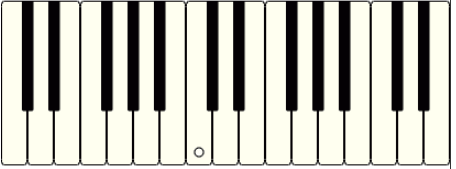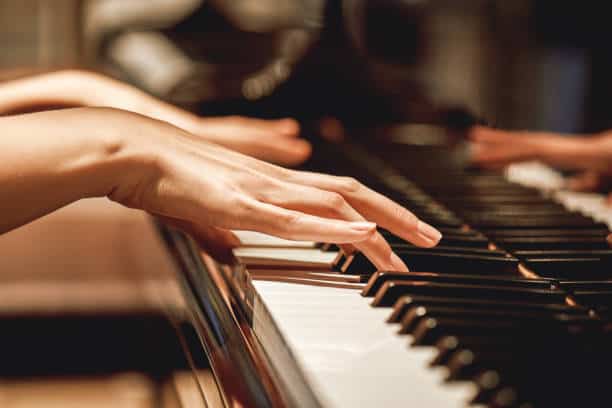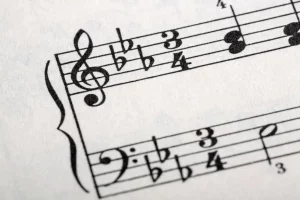Middle C is often the first note the beginners learn to identify on the piano. It is a solid foundation to begin any piano study.
How to find middle C on the piano
Middle C is quite easy to find on the piano. Take a minute to look at the keyboard. Do you notice any patterns in the arrangement of the keys? The piano keys are organized into groups of two and three black keys. This layout is a useful tool for developing great piano technique.
Find the group of two black keys more or less in the middle of the piano. Take a look at this diagram if you are lost:

Middle C on 88 key keyboard
Middle C is the key on the outside left hand side of the group of two black keys in the middle of the piano. You can label piano keys, and here it is labeled on an 88 key keyboard:

Middle C on 61 key keyboard
And here it is labeled on a 61 key keyboard:

Not too difficult, right? Now that you know how to find middle C on the piano, stand up, walk to the other side of the room, come back to the piano and find it again. Repeat this exercise 5 or 10 times until you are comfortable finding middle C every single time. Nice work!
Why is middle C called middle C?
At this point you may have noticed that middle C is sort of in the middle of the keyboard. It is not truly the middle. What note is in the middle of an 88 key keyboard? Try this: start at the lowest note and the highest note and work your way to the note in the middle. What do you find?

There is no note that fits perfectly in the middle of the keyboard!
What about a 61 key keyboard? If you have a 61 key instrument, practice this same exercise. What do you discover?

A 61 key instrument has a key that fits perfectly in the middle. That note is called F sharp.
But, if middle C is not in the middle of the piano, then why is it called middle C? The answer requires a little more explanation.
The grand staff
Middle C is called middle C because it is in the middle of the grand staff. Piano music is most commonly notated on the grand staff. The grand staff is the combination of treble and bass clef joined together with a bracket. The grand staff looks like this:

The treble clef is the tool most commonly used to notate music in the right hand on the piano. Middle C is notated here in treble clef:

The Bass clef is the tool most commonly used to notate music in the left hand on the piano. The bass clef notes are most commonly found below middle C.
Middle C is notated here in bass clef:

These are the same note. On the grand staff, this note is located here:

See how this C note is directly in the middle of the grand staff? This is why this C is called middle C, not because it happens to be sort of close to the middle of the keyboard. Cool, right?
A basic warmup exercise from middle C
With your right hand, find middle C with your first finger (your thumb). Play middle C with your first finger, followed by the next key, D with your second finger (index finger), then the next key E with your third finger (middle finger), followed by the next key F with your fourth finger (ring finger), and finally G with your fifth finger (pinky finger). You have now played all the white keys from C-G in sequential order with each of your five fingers. This is the first half of the exercise.
Now you will play the second half. Start with your fifth finger (pinky finger) on G, followed by your fourth finger (ring finger) on F, your third finger (middle finger) on E, your second finger (index finger) on D and finally your first finger back on middle C (thumb).
Follow the diagram of the keys below if you get a little lost:

Practice this exercise up and down a few times until you feel comfortable with the movement. When you feel comfortable, repeat the exercise with your left hand. Begin with your left hand fifth finger (pinky finger) on middle C, fourth finger (ring finger) on D, third finger (middle finger) on E, second finger (index finger) on F, and first finger (thumb) on G. Now descend from G with your first finger, second finger on F, third finger on E, fourth finger on D, and finally pinky finger on middle C. Congratulations!
You can practice this warmup from any note by following the same finger pattern, but it is especially useful for finding and practicing from middle C.
The middle of all keyboards
Middle C is a basic foundation note. It is the first note that beginning pianists learn to find on the piano. It is on the outside left side of the group of two black keys in the middle of the piano. However, middle C is not called middle C because it is in the middle of the piano. Middle C is called middle C because it is in the middle of the grand staff, the combination of treble and bass clef that piano music is most commonly notated on!
For more information on middle C, check out this awesome video:
Author of this blog post

Eddie Bond is a multi-instrumentalist performer, composer, and music instructor currently based in Seattle, Washington USA. He has performed extensively in the US, Canada, Argentina, and China, released over 40 albums, and has over a decade experience working with music students of all ages and ability levels.















